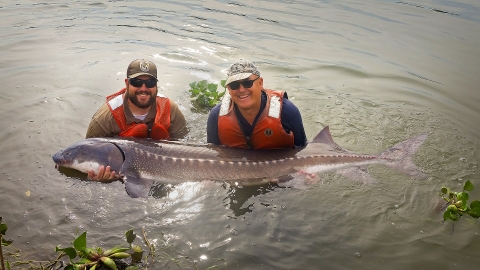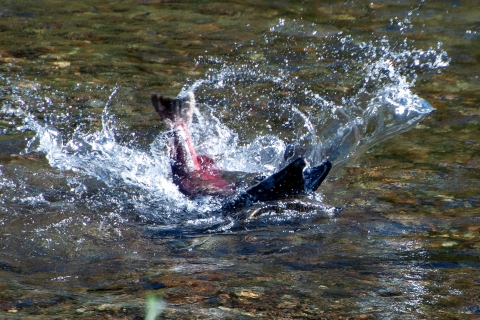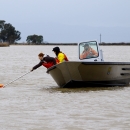Anadromous Fish Restoration Program, Lodi Fish and Wildlife Office
Populations of native anadromous fishes (i.e., Chinook salmon, steelhead, white sturgeon and green sturgeon) have declined dramatically since the 1800s. Hydraulic mining, dams and other human activities have led to habitat degradation and barriers to migration that have harmed populations of migratory fishes.
The declines have been so dramatic that some species may be in danger of extinction. For example, winter-run Chinook salmon are listed as endangered, and green sturgeon are listed as threatened under both federal and California Endangered Species acts. In addition, all other races of Chinook salmon and steelhead have been petitioned for either federal or state listing.
The goal of the Anadromous Fish Restoration Program is to make all reasonable efforts to at least double natural production of anadromous fish in California's Central Valley streams on a long-term, sustainable basis. The AFRP is a result of the Central Valley Project Improvement Act, which directs the Department of the Interior to attempt the doubling goal for fishes like salmon and sturgeon while also maintaining a reasonable balance among competing demands among fish and wildlife, agriculture, industry and municipal needs.
The AFRP works to achieve this goal through a variety of projects throughout the Central Valley. We work cooperatively with other federal, state and local agencies, nonprofits, for-profit institutions, universities and private landowners on projects that increase available juvenile and adult salmon habitat.
To see the watersheds under AFRP jurisdiction, view this map. Watersheds from the Yuba River and and south are covered by the Lodi FWO. Watersheds north of the Yuba River are under the purview of the Red Bluff AFRP program.
Funding Opportunities
National Culvert Removal, Replacement, and Restoration Grant Program (Closing date: 02/06/2023)
California Fish Passage Forum FY24 Request for Proposals (Closing date: 02/27/2023)
Additional funding announcements may also be available through the USBR AFRP page, National Fish Habitat Partnership, California Fish Passage Forum, and Grants.gov.
Restoration Examples
Hallwood Restoration Project, Yuba River. The Hallwood Restoration Project will improve habitat in the lower Yuba River for Chinook salmon and steelhead. In an area consisting of cobble embankments, this project seeks to enhance or create up to 157 acres of seasonally-inundated riparian riparian
Definition of riparian habitat or riparian areas.
Learn more about riparian floodplain habitats, perennial side channels, and seasonal side channels, alcoves, and swales.
Low Flow Crossings, Calaveras River. The Caprini Low Flow Crossing was a barrier to fish passage fish passage
Fish passage is the ability of fish or other aquatic species to move freely throughout their life to find food, reproduce, and complete their natural migration cycles. Millions of barriers to fish passage across the country are fragmenting habitat and leading to species declines. The U.S. Fish and Wildlife Service's National Fish Passage Program is working to reconnect watersheds to benefit both wildlife and people.
Learn more about fish passage and was identified by a collaborative process as high priority for improvement. The new design not only improved fish passage for steelhead and Chinook salmon. The Hosie Low Flow Crossing project was recently funded . These project represent collaborative efforts with the land owners, Stockton East Water District, California Department of Water Resources, the California Department of Fish and Wildlife, and the U.S. Fish and Wildlife Service.
Nimbus Basin and Lower Sailor Bar, American River. The projects at Nimbus Basin and Lower Sailor Bar will enhance crucial habitat for native Chinook salmon and steelhead by collectively laying approximately 41,000 cubic yards of clean gravel into the river and creating side channels into existing gravel bars. Project teams will add large woody material and plant riparian vegetation. These elements will create habitat for young fish to hide from predators and feed.






